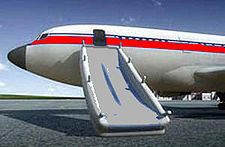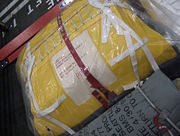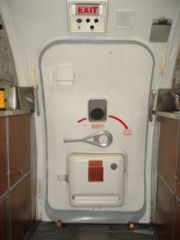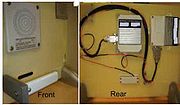
Evacuation slide
Encyclopedia

Aircraft
An aircraft is a vehicle that is able to fly by gaining support from the air, or, in general, the atmosphere of a planet. An aircraft counters the force of gravity by using either static lift or by using the dynamic lift of an airfoil, or in a few cases the downward thrust from jet engines.Although...
quickly. An escape slide is required on all commercial (passenger carrying) aircraft where the door sill height is such that, in the event of an evacuation, passengers would be unable to "step down" from the door uninjured (Federal Aviation Administration
Federal Aviation Administration
The Federal Aviation Administration is the national aviation authority of the United States. An agency of the United States Department of Transportation, it has authority to regulate and oversee all aspects of civil aviation in the U.S...
requires slides on all aircraft doors where the floor is 6 feet (1.8 m) or more above the ground).
Escape slides are packed and held within the door structure inside the slide bustle, a protruding part of the inside of an aircraft door that varies in size depending on both the size of the aircraft and the size of the door.
Many, but not all slides are also designed to double as life rafts in case of a water landing
Water landing
A water landing is, in the broadest sense, any landing on a body of water. All waterfowl, those seabirds capable of flight, and some human-built vehicles are capable of landing in water as a matter of course....
.
Window exits

Flap (aircraft)
Flaps are normally hinged surfaces mounted on the trailing edges of the wings of a fixed-wing aircraft to reduce the speed an aircraft can be safely flown at and to increase the angle of descent for landing without increasing air speed. They shorten takeoff and landing distances as well as...
are fully lowered, the wings are low enough to the ground that passengers can evacuate safely. Some of these aircraft are the Embraer 190, Boeing 707
Boeing 707
The Boeing 707 is a four-engine narrow-body commercial passenger jet airliner developed by Boeing in the early 1950s. Its name is most commonly pronounced as "Seven Oh Seven". The first airline to operate the 707 was Pan American World Airways, inaugurating the type's first commercial flight on...
, 717
Boeing 717
The Boeing 717 is a twin-engine, single-aisle jet airliner, developed for the 100-seat market. The airliner was designed and marketed by McDonnell Douglas as the MD-95, a third-generation derivative of the DC-9. Capable of seating of up to 117 passengers, the 717 has maximum range of...
, 727
Boeing 727
The Boeing 727 is a mid-size, narrow-body, three-engine, T-tailed commercial jet airliner, manufactured by Boeing. The Boeing 727 first flew in 1963, and for over a decade more were built per year than any other jet airliner. When production ended in 1984 a total of 1,832 aircraft had been produced...
and 737
Boeing 737
The Boeing 737 is a short- to medium-range, twin-engine narrow-body jet airliner. Originally developed as a shorter, lower-cost twin-engine airliner derived from Boeing's 707 and 727, the 737 has developed into a family of nine passenger models with a capacity of 85 to 215 passengers...
. However, other aircraft require the use of overwing slides for the window exits to ensure passengers are able to reach the ground quickly and safely. These include Boeing 767
Boeing 767
The Boeing 767 is a mid-size, wide-body twin-engine jet airliner built by Boeing Commercial Airplanes. It was the manufacturer's first wide-body twinjet and its first airliner with a two-crew glass cockpit. The aircraft features two turbofan engines, a supercritical wing, and a conventional tail...
, Boeing 757
Boeing 757
The Boeing 757 is a mid-size, narrow-body twin-engine jet airliner manufactured by Boeing Commercial Airplanes. Passenger versions of the twinjet have a capacity of 186 to 289 persons and a maximum range of , depending on variant and cabin configuration...
, Airbus A320
Airbus A320
The Airbus A320 family is a family of short- to medium-range, narrow-body, commercial passenger jet airliners manufactured by Airbus Industrie.Airbus was originally a consortium of European aerospace companies, and is now fully owned by EADS. Airbus's name has been Airbus SAS since 2001...
-series aircraft. Typically, overwing evacuation slides are not designed for use in ditching situations as they cannot be detached and will not operate, as the system is disabled by the aspirators on the slide taking in water.
Window exits usually come in two configurations:
- An unhinged hatch type exit, where the hatch is unlocked from the inside and pulled into the cabin, whereupon it can be disposed. Some carriers recommend placing the hatch onto the adjacent seats, while others may recommend dropping it in the next seat row, or rotating the exit and throwing it outside the aircraft as far forward as possible. A manual inflation handle for the evacuation slide, if equipped, can be found in the window frame. Most aircraft overwing exitsOverwing exitsOverwing exits are found on passenger aircraft to provide a means of passenger evacuation onto the wing, where they either continue off the trailing edge by sliding down the extended flaps or by using an evacuation slide that deploys when the exit is opened....
are of this type. - A hinged "self disposing" exit hatch, that opens automatically outward using a spring when the exit handle is pulled. This exit design was designed in response to research generated after the Manchester air disasterBritish Airtours Flight 28MBritish Airtours Flight 28M was an international passenger flight on 22 August 1985 which originated from Manchester International Airport's Runway 24 in Manchester, England en-route to Corfu International Airport on the Greek island of Corfu. The aircraft, previously named "Goldfinch" but at the...
in 1985 which indicated that unhinged hatch type exits were difficult to open by untrained passengers. This design is currently found only on Boeing 737 NG aircraft.
Window exits are usually equipped with "ditching" or "life" lines. These may be attached to the inside frame of the window exit, or located in a nearby storage locker. One end has a buckle to connect to attachments on the aircraft's wings.
History
The first aircraft evacuation slide was developed and produced by Air Cruisers, founded by James F. Boyle, inventor of the WWII life vest, the "Mae West". Prior to inflateables, some passenger aircraft utilized canvas type slides which required the crew to undertake an extensive rigging procedure. Canvas type slides are still found on some Russian aircraft. Australian aviation pioneer Jack Grant (Qantas), developed the first inflatable evacuation slide/raft for aircraft in 1965. Grant's design introduced technology based on the science of pressure and revolutionized air travel safety which is still standard equipment on all major world airlines. The patent for the "Inflatable Escape Chute Assembly" was submitted by Boyle in 1954 and the designs was patented in 1956 under patent number 2,765,131. Today Air Cruisers provides slides for over 65% of the aircraft slide market.Types


Slides can also be single or dual lane, depending on the width of the exit, a dual lane slide being capable of evacuating a greater number of people quickly in an evacuation.
Slides and slide/rafts can be detached from the girt bar, usually by a two or three step procedures. This may, for example, involve lifting up the flap on the girt bar, and pulling the detach handle. These procedures are usually placarded red on the slide, "For Ditching Use Only". Once the slide is separated, the slide remains attached to the aircraft by a mooring line. This line will break if the airframe submerges, or can be disconnected with a pre-supplied knife or disconnect handle.
A ramp slide is an evacuation slide that has a small platform between the exit and the slide itself, and is used mainly where the proximity of the exit to an engine requires the slide to be angled away from the engine to prevent damage. Airbus A310
Airbus A310
The Airbus A310 is a medium- to long-range twin-engine widebody jet airliner. Launched in July 1978, it was the second aircraft created by Airbus Industrie,a consortium of European aerospace companies, Airbus is now fully owned by EADS and since 2001 has been known as Airbus SAS. the consortium of...
, Airbus 340-600, Airbus A380
Airbus A380
The Airbus A380 is a double-deck, wide-body, four-engine jet airliner manufactured by the European corporation Airbus, a subsidiary of EADS. It is the largest passenger airliner in the world. Due to its size, many airports had to modify and improve facilities to accommodate it...
and Boeing 747
Boeing 747
The Boeing 747 is a wide-body commercial airliner and cargo transport, often referred to by its original nickname, Jumbo Jet, or Queen of the Skies. It is among the world's most recognizable aircraft, and was the first wide-body ever produced...
aircraft have ramp slide attachments for their overwing evacuation slides. The overwing exits on the Airbus A320
Airbus A320
The Airbus A320 family is a family of short- to medium-range, narrow-body, commercial passenger jet airliners manufactured by Airbus Industrie.Airbus was originally a consortium of European aerospace companies, and is now fully owned by EADS. Airbus's name has been Airbus SAS since 2001...
series, Boeing 757
Boeing 757
The Boeing 757 is a mid-size, narrow-body twin-engine jet airliner manufactured by Boeing Commercial Airplanes. Passenger versions of the twinjet have a capacity of 186 to 289 persons and a maximum range of , depending on variant and cabin configuration...
-variant and Boeing 767
Boeing 767
The Boeing 767 is a mid-size, wide-body twin-engine jet airliner built by Boeing Commercial Airplanes. It was the manufacturer's first wide-body twinjet and its first airliner with a two-crew glass cockpit. The aircraft features two turbofan engines, a supercritical wing, and a conventional tail...
-variant aircraft also utilize ramp slide attachments.
Another unique type of evacuation slide is found on certain DC-9, MD-80 and Boeing 717
Boeing 717
The Boeing 717 is a twin-engine, single-aisle jet airliner, developed for the 100-seat market. The airliner was designed and marketed by McDonnell Douglas as the MD-95, a third-generation derivative of the DC-9. Capable of seating of up to 117 passengers, the 717 has maximum range of...
aircraft. This type of slide is located in the aircraft's tailcone. This slide deploys after the tailcone is jettisoned by flight attendants, allowing for evacuation through the rear of the airframe. The procedure to use this exit may involve removing a plug-type pressure bulkhead, or a swing type door that leads directly to a walkway. At the end of the walkway is the slide pack and a manual tailcone jettison handle for use if the tailcone has not already been automatically jettisoned by opening the walkway entrance.
Certain evacuation slides do not use a slide bustle on the door as a container. Instead, the slide is "fuselage mounted" and is attached to a container located underneath or below the exit close to the aircraft exterior. This design of slide is found in the Airbus A321 aircraft at the emergency doors, and typically at all overwing evacuation slides other than the Boeing 747-400
Boeing 747-400
The Boeing 747-400 is a major development and the best-selling model of the Boeing 747 family of jet airliners. While retaining the four-engine wide-body layout of its predecessors, the 747-400 embodies numerous technological and structural changes to produce a more efficient airframe...
series aircraft.
One of the newest development in evacuation slide technology can be found on the Airbus A380
Airbus A380
The Airbus A380 is a double-deck, wide-body, four-engine jet airliner manufactured by the European corporation Airbus, a subsidiary of EADS. It is the largest passenger airliner in the world. Due to its size, many airports had to modify and improve facilities to accommodate it...
, which was developed by Goodrich Aircraft Interior Products. Certain slides on board the aircraft have the Tribrid Inflation System, which is connected to a sensing system within the door. If the door is opened in emergency mode at an abnormal attitude (e.g. nose up position due to the loss of landing gear), the slide will inflate normally but will also inflate several feet of additional slide to ensure the slide reaches the ground. This compares differently to the Boeing 747
Boeing 747
The Boeing 747 is a wide-body commercial airliner and cargo transport, often referred to by its original nickname, Jumbo Jet, or Queen of the Skies. It is among the world's most recognizable aircraft, and was the first wide-body ever produced...
as doors found on that aircraft have no such system; should the slide not reach the ground, the doors must be blocked to prevent passenger injury.
Operation
Prior to departure (usually before engine startup) all the aircraft doors are placed into the armed (or automatic) mode by the cabin crewFlight attendant
Flight attendants or cabin crew are members of an aircrew employed by airlines primarily to ensure the safety and comfort of passengers aboard commercial flights, on select business jet aircraft, and on some military aircraft.-History:The role of a flight attendant derives from that of similar...
. Methods of arming vary from aircraft to aircraft, but ultimately what is involved is the girt bar (a metal bar attached to the door end of the slide) being physically attached to brackets either in or adjacent to the door sill. On older aircraft, such as the Boeing 737
Boeing 737
The Boeing 737 is a short- to medium-range, twin-engine narrow-body jet airliner. Originally developed as a shorter, lower-cost twin-engine airliner derived from Boeing's 707 and 727, the 737 has developed into a family of nine passenger models with a capacity of 85 to 215 passengers...
, this is done physically by the cabin crew and on most other aircraft it involves pushing a lever on the door itself which arms the door internally.
If a rapid evacuation is required and the doors are opened while "armed", the opening of the door pulls the slide pack out of the bustle (because the girt bar is physically attached to the aircraft floor). Due to the weight of both the door and the slide, great effort is involved in pushing the door open sufficiently to free the slide from the bustle, thus on larger aircraft a "power assist" function kicks in to aid the opening, either electrically or from compressed gas. Once the slide is completely free it will fall under gravity and after travelling a certain distance a pin will be pulled from a squib containing compressed gas and the slide will inflate. Should this system fail, the slide can be manually inflated by the cabin crew by pulling a manual inflation handle at the top of the slide. Should this also fail, standard operating procedures require the cabin crew to send passengers away from the door and to one that has a functioning escape slide.
Some Russian-built aircraft like the Tupolev Tu-154
Tupolev Tu-154
The Tupolev Tu-154 is a three-engine medium-range narrow-body airliner designed in the mid 1960s and manufactured by Tupolev. As the mainstay 'workhorse' of Soviet and Russian airlines for several decades, it serviced over a sixth of the world's landmass and carried half of all passengers flown...
have a very complicated process to activate and deploy the slides. The slides are stored in cabinets usually beside the emergency exit inside the aircraft. There are usually about the same width and height as a seat. To activate the slide, one must pull the front cover to a 90 degree angle, then pull the slide out so it is lying flat on the floor or door sill, open the emergency exit and kick or push it out. Gravity will then pull the slide to the ground and it will inflate.
Aircraft safety card
Aircraft safety card
An aircraft safety card is a document instructing passengers on an aircraft about the procedures for dealing with various emergency conditions that might arise during the flight....
s and in-flight safety demonstration
In-flight safety demonstration
The pre-flight safety demonstration is a detailed explanation given before takeoff to airline passengers about the safety features of a commercial aircraft.On smaller aircraft this may take place in the form of a live briefing performed by...
s show the passengers where the nearest emergency exits are and how to use the evacuation slides. Additionally, Flight Attendant
Flight attendant
Flight attendants or cabin crew are members of an aircrew employed by airlines primarily to ensure the safety and comfort of passengers aboard commercial flights, on select business jet aircraft, and on some military aircraft.-History:The role of a flight attendant derives from that of similar...
s receive extensive safety training that covers the use of evacuation slides.
Usage
In an article in TIME, Amanda Ripley and Dan Johnson, an aviation safety expert, compiled some tips on how to avoid injury and escape from a plane on an inflatable slide. Here are their suggestions. Number one: Have a Plan. Know where the exits are when you sit down on a plane. Two: Have a back-up plan. Passengers often have trouble opening the exit hatches and slides sometimes malfunction. Three: Get out fast. Don't even think about grabbing your overhead luggage. Four: Jump! Johnson says if everyone would jump the evacuation could go 50% faster. And faster is better. Five: to avoid burns, keep your heels up and your arms crossed over your chest. Women should avoid wearing pantyhose and spiked heels when they fly. The hose can melt onto the skin in the heat of a plane fire and the heels can pop the emergency slide. Six: When you reach the bottom, get out of the way. Pile-ups at the bottom of the slide can be brutal and slow down the exit for everyone.Inadvertent deployment

A device can be used to prevent this problem. It works by sounding an audible alert (voice) when the door operator, whether trained or not, is about to open the door in the armed position. It works as an independent system, requiring no action other than arming the door as per normal standard operating procedures. When the door is placed in the armed position, the device is armed. It can be installed as a stand alone unit or integrated into the aircraft systems and powered from aircraft power.
Inflation systems
Both slides and slide/rafts use a non-explosive, inert gas inflation systems. The FAA requires evacuation of the entire aircraft in 90 seconds using 50% of the available evacuation exits. To meet this, all evacuation units need to deploy in less than 10 seconds. For large, wide body aircraft such as A300's and B747's a successful deployment is complete in about 5–7 seconds, depending on conditions (such as cold and winds).The inflation system usually consists of a pressurized cylinder, a regulating valve, two high pressure hoses and two Aspirators. The cylinder can be from 100 to about 1000 cubic inches, filled to about 3000 psi with either gaseous Nitrogen, or a mixture of gaseous CO2 and Nitrogen. Once made of steel, most cylinders now are made of aluminum or alloy cores wrapped with fiberglass, or other lightweight, fuel saving materials. The CO2 is used to slow down the rate at which the valve expends the gases.
The valve is used to mechanically meter out the gas at a rate of roughly 3 - 600 psi and 4 CFM. Typically there are two high pressure hoses attached to the valve, which are connected at the other end to 'Aspirators'. These are usually cylindrical, hollow aluminum tubes with sliding cylindrical or internal 'flapper' doors that open when high pressure gas is applied, and close when the gas stream subsides and the internal slide back pressure reaches about 2.5 - 3.0 psi. They work on the 'Venturi' principle, and draw outside air into the evacuation unit at a rate of about 500:1. A 750 in3 (0.43 ft3) cylinder can fill a slide with about 850 cu ft (24.1 m³). of air to a pressure of about 3 psi in about 4 – 6 seconds.
In order for the slide to deploy correctly, it is packed in a manner that has the aspirators directly under the outer cover.
The entire, self contained 'slide pack' is approximately 3 ft (0.9144 m). wide, 2.5 ft (0.762 m). wide and about 12" high, depending on aircraft type. In the center, forward part of the pack, a multi-layered piece of heavy urethane or neoprene/nylon fabric, called the 'girt', is left hanging out to a length of about 2 ft (0.6096 m). When installed in the aircraft, a 'girt bar' is put through the center, outside end of the girt and attached to the interior floor, just inside and in front of the exit door. On the face of the girt are instructions in large red lettering, and a handle with the word 'PULL' on it.
This is rarely used however, because the lanyard attached to the handle runs through the girt to the valve, which is several inches too short when the girt is extended fully. When the slide is in the 'armed' position and the door is opened, the slide pack falls free of the door bustle (a semi-rigid outer container) and the weight and momentum of the slide pulls the lanyard from the valve, initiating the flow of gas. At about the same time, a metal pin that holds the center of the Valise closed is also pulled, releasing a 'daisy chain' and the two halves of the cover. When the cover is released and the inflation system activated, the two aspirators come shooting out of the pack, gulping vast quantities of air and restrained only by the fabric tubes to which they are securely fastened.
In order to compensate for any wind, new evacuation slides contain internal baffles, which cause the ends nearest the aircraft to inflate first, which are constructed to come out like four elbows and press against the fuselage of the aircraft, to the forward and aft sides of the exit door. There are also 'half-tie' restraints which keep the inflating slide from drooping or blowing under the aircraft. These restraints are constructed so that when the slide becomes fairly rigid, around 1.5 - 2.0 psi, they detach very quickly (there are usually two), and since the header tubes are already against the fuselage, the slide 'pops' almost horizontally out from the door, then drops relatively gently to the ground. Tests in 25 knots (49 km/h) cross winds have shown these deployment systems to be very effective.
Independent of the inflation system, all slides are equipped with at least one pressure relief device per inflation chamber. This protects the chamber from catastrophic failure due to over pressurizing. (Typically, modern slides are made of at least 2 inflation chambers, and should be able evacuate an aircraft even when one chamber loses all pressure.)
All new evacuation slides are tested on a mock-up of an aircraft exit door and filmed prior to being certified as 'airworthy' and delivered to a customer. Also, new units are usually constructed of urethane materials and impregnated or coated with an aluminized coating in order that the slide will survive for a short while even if fire is nearby. Older slides are yellow and made of neoprene/nylon fabric.

